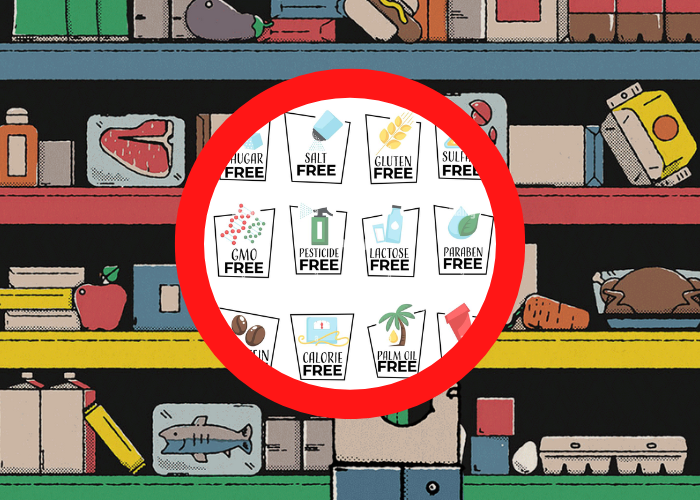The strange case of “free-from” labelsBY PIETRO PAGANINI
- 6 December 2022
- Posted by: Competere
- Category: Senza categoria

Over the past decade, the “free-from” trend has exploded in the food industry. “Free-from” means that a particular ingredient is absent or has been substituted to satisfy the consumer’s desire, need, or fear. For example, free-from sugar, salt, GMOs, dyes, grains, sweeteners, lactose, gluten, butter, palm oil, etc. Foods labeled “free-from” are joined by those with “less,” less calories, fat, saturated fat, salt, sugar, etc. Among these, the most popular (it changes from country to country) are “sugar-free,” “gluten-free,” and “palm oil-free.”
CHANGING COURSE
The “free-from” on the label has replaced the “with the addition of” that was fashionable in the early 2000s. Previously, the label indicated that an ingredient had been added to meet the consumer’s wants or needs, signaling a shift from the addition of something to the absence of something else. In the wake of the Covid-19 pandemic, the trend has slowly reversed once again. Fear of the virus has prompted consumers to demand that an ingredient to protect against the virus be in foods.
“FREE-FROM” TO INFORM
The “free-from” can be used to inform the consumer with special medical needs (allergies, for example) that the particular ingredient (from which the allergy derives) has been eliminated, such as is the case with gluten-free products. With “sugar-free” products, the label is intended to inform the consumer that an ingredient with a particular caloric intake, and therefore a danger to diabetics, has been removed.
BUT WHAT ABOUT PALM OIL?
However, there are no valid reasons to include “palm oil-free” on labels. It is a commercial ploy to reach those misinformed consumers who consider palm oil dangerous to their health or to sustainability and thus the ecosystem. Consumers have, in fact, been misinformed about palm oil. This is no accident as companies benefited from the boycott of palm oil.
THE HISTORY OF THE BOYCOTT
The first palm oil boycott dates back to the 1990s in the United States. Soybean producers resented the competitiveness of palm oil. They boycotted it, accusing it of being unhealthy. At the time there was little sensitivity to the issue of sustainability and workers’ rights.
The boycott was very short-lived because the Malaysian government, a leading producer of palm oil, reached a political agreement with the U.S. government. In addition, the Food & Drug Administration (FDA) banned the use of so-called negative claims, such as “palm oil-free.”
In Europe, the legislation on “ingredient-free products” remains confusing, bouncing between the EU Commission and member country governments. The revision of the Front of Pack Regulation that the commission is working on will not solve the problem. In fact, in the EU, the “palm oil-free” label has been spreading concurrently with the boycott campaign that several organizations with various arguments have unleashed for the old continent. For the EU, as for the Italian government, the “palm oil-free” label must indicate a benefit to the consumer otherwise it should not be used. But there is no enforcement of this rule, and, as I illustrate below, there is no benefit to eliminating palm oil. These conclusions confirm that there is a disparaging commercial campaign against palm oil.
It was French rapeseed oil producers who, first with the support of local NGOs and later with the backing of international NGOs, started the campaign. The competitiveness of palm oil was taking large chunks of the market away from rapeseed, and thus the many European funds that come from the CAP (Common Agricultural Policy), the EU’s main budget item. The French farmers’ charge is that the oil palm supply chain causes deforestation in Southeast Asia.
ITALY AND THE SUCCESS OF “FREE-FROM”
But the success of “free-from” finds its most fertile ground in Italy. The reason is again commercial and specifically related to the market for creamy spreads and cookies. There is a market leader that employs the best palm oil for quality (very low level of contaminants) and sustainability (sustainability certification and traceability). To try to weaken it, it is being attacked on the points considered weakest, such as the Italianness of its ingredients, the amount of sugar, and indeed, the presence of palm oil. In Italy and Spain, alongside many other European countries, one of the most aggressive campaigns demonizing palm oil is built on falsehood. First, palm oil is accused of being bad for consumers’ health: it contains a very high level of saturated fat and too many contaminants. The campaigns also claim palm oil is bad for the environment, despite that scientific studies, facts, and evidence say otherwise. Not least because the European Food Safety Authority (EFSA) in a report published in 2016 on contaminants in vegetable oils informs readers that “(…contaminants found in palm oil, but also in other vegetable oils, margarines, and some processed foods, might raise potential health concerns for average consumers…).” The biased and unscientific claim that “palm oil but other vegetable oils” contain potentially dangerous contaminants is enough to intensify the boycott. In 2018, EFSA published a revision of the first report changing the risk limits. In 2021, the EU Commission published the 3-MCPD contaminants regulation. All oils, including palm oil, entering Europe are under those limits.
Over 70% of people held a negative perception of palm oil Italy. Many food companies, frightened by the EFSA report, replaced palm oil with sunflower oil. Palm oil-free products grew exponentially between 2016 and 2018, then declined until 2021 (+13.5, +12.9, +3.8, +1.6, +2.3, +1.2).
REPUTATION IMPROVES
From 2018 to 2021, the reputation of palm oil in Italy has been gradually improving. Just under 4 out of 10 consumers consider it potentially dangerous. In fact, over the years, consumers have become more informed. Science and scientific evidence have prevailed. A study showed that products that removed palm oil did not reduce saturated fat. In many cases (95%) there was an increase in saturated fat. Just as we have shown that to have a carcinogenic risk an 80kg individual must ingest 48.5 kg of palm oil (the equivalent of 388 kg of cookies) (Glycidyl Esters), and 5.4 kg of oil, or 25 kg of cookies, (Chloropropanol). Despite these figures and the EU’s regulation, many media outlets continue to repeat that palm oil is full of dangerous contaminants.
The narrative does not change when it comes to sustainability. Italy and Spain are less environmentally sensitive and more health conscious. While in the rest of Europe it is the same. Indeed, it was in Northern Europe that the myth that palm plantations cause the planet’s ills was born. Paradoxically, some of the brands resorting to “free-from” are also affiliated with the Roundtable on Sustainable Palm Oil (RSPO).
LACK OF SUNFLOWER OIL: THE RETURN TO OIL PALM
The numbers show that even before the sunflower oil crisis in Italy, the “free-from” trend was brewing. There are several reasons for this: consumer tastes and fears are changing (especially in light of the Covid-19 pandemic), science and scientific evidence have prevailed over commercial lies, the anticipated gains from “free-from” have not come. It will be interesting to understand what changes as a result of the Ukrainian sunflower crisis. Many companies are switching or reverting to palm oil. This will inevitably lead to a reduction in “free-from,” despite some NGOs and biased media continuing with the rant. But this time consumers are more prepared and primarily concerned about prices and the dangerous food crisis.
This is not the end of “free-from.” Palm oil producers should not breathe a sigh of relief. It is in these moments that conditions must be built for oil palm to be accepted and no longer discriminated against. Although, to use a sports metaphor, whoever wins attracts envy. So, if palm oil is winning, the “free-from” is the weapon of the envious.

